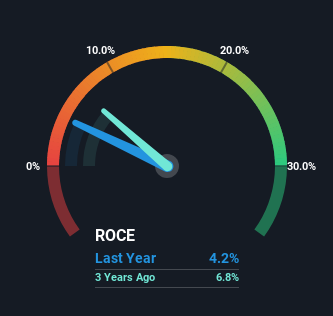- India
- /
- Trade Distributors
- /
- NSEI:HARDWYN
Hardwyn India (NSE:HARDWYN) Is Doing The Right Things To Multiply Its Share Price

If you're looking for a multi-bagger, there's a few things to keep an eye out for. In a perfect world, we'd like to see a company investing more capital into its business and ideally the returns earned from that capital are also increasing. This shows us that it's a compounding machine, able to continually reinvest its earnings back into the business and generate higher returns. With that in mind, we've noticed some promising trends at Hardwyn India (NSE:HARDWYN) so let's look a bit deeper.
Return On Capital Employed (ROCE): What Is It?
For those who don't know, ROCE is a measure of a company's yearly pre-tax profit (its return), relative to the capital employed in the business. Analysts use this formula to calculate it for Hardwyn India:
Return on Capital Employed = Earnings Before Interest and Tax (EBIT) ÷ (Total Assets - Current Liabilities)
0.042 = ₹160m ÷ (₹4.3b - ₹477m) (Based on the trailing twelve months to September 2023).
So, Hardwyn India has an ROCE of 4.2%. On its own, that's a low figure but it's around the 4.9% average generated by the Trade Distributors industry.
View our latest analysis for Hardwyn India

While the past is not representative of the future, it can be helpful to know how a company has performed historically, which is why we have this chart above. If you want to delve into the historical earnings, revenue and cash flow of Hardwyn India, check out these free graphs here.
The Trend Of ROCE
Even though ROCE is still low in absolute terms, it's good to see it's heading in the right direction. The numbers show that in the last five years, the returns generated on capital employed have grown considerably to 4.2%. Basically the business is earning more per dollar of capital invested and in addition to that, 4,269% more capital is being employed now too. The increasing returns on a growing amount of capital is common amongst multi-baggers and that's why we're impressed.
On a related note, the company's ratio of current liabilities to total assets has decreased to 11%, which basically reduces it's funding from the likes of short-term creditors or suppliers. Therefore we can rest assured that the growth in ROCE is a result of the business' fundamental improvements, rather than a cooking class featuring this company's books.
What We Can Learn From Hardwyn India's ROCE
To sum it up, Hardwyn India has proven it can reinvest in the business and generate higher returns on that capital employed, which is terrific. Since the stock has returned a solid 99% to shareholders over the last year, it's fair to say investors are beginning to recognize these changes. With that being said, we still think the promising fundamentals mean the company deserves some further due diligence.
If you'd like to know about the risks facing Hardwyn India, we've discovered 1 warning sign that you should be aware of.
While Hardwyn India isn't earning the highest return, check out this free list of companies that are earning high returns on equity with solid balance sheets.
Valuation is complex, but we're here to simplify it.
Discover if Hardwyn India might be undervalued or overvalued with our detailed analysis, featuring fair value estimates, potential risks, dividends, insider trades, and its financial condition.
Access Free AnalysisHave feedback on this article? Concerned about the content? Get in touch with us directly. Alternatively, email editorial-team (at) simplywallst.com.
This article by Simply Wall St is general in nature. We provide commentary based on historical data and analyst forecasts only using an unbiased methodology and our articles are not intended to be financial advice. It does not constitute a recommendation to buy or sell any stock, and does not take account of your objectives, or your financial situation. We aim to bring you long-term focused analysis driven by fundamental data. Note that our analysis may not factor in the latest price-sensitive company announcements or qualitative material. Simply Wall St has no position in any stocks mentioned.
About NSEI:HARDWYN
Hardwyn India
Manufactures and trades in architectural hardware and glass fittings to residential and commercial structures under the Hardwyn brand in India.
Excellent balance sheet with questionable track record.
Similar Companies
Market Insights
Community Narratives




